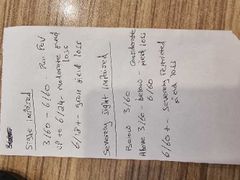![]()
![]()
![]()
Use LEFT and RIGHT arrow keys to navigate between flashcards;
Use UP and DOWN arrow keys to flip the card;
H to show hint;
A reads text to speech;
23 Cards in this Set
- Front
- Back
|
Angular Mag Formula |
AM = qL/1 - dL' |
|
|
Linear Mag |
M = L/L' h' = h x L/L' thick: h' = h x L1/L1' x L2/L2' |
|
|
Nom and Max Mag |
F/4 F/4 +1 |
|
|
Telescope Mag formula |
M = -Fe/Fo |
|
|
Lens Cap and Total Mag |
Fcap/4 x -Fe/Fo |
|
|
SI and SSI registration groups |

|
|
|
Which form is used for the registration of SI and SSI pxs? |
Certificate of Vision Impairment (CVI) |
|
|
Vergence arriving at the eye |
l2 = l1' - d 1/l2 = L2 |
|
|
Advantages of dv telescopes |
Only realistic option for Dv mag Good depth of field Can be hands free Only practical solution for long inter wd Can be mono/bin Variable focus |
|
|
Disadvantages of dv telescopes |
High cost Difficult to use Extensive training Very poor FOV Heavy Conspicuous device |
|
|
Markings: 8x20x7.5 |
8 = magnification 20 = objective diameter 7.5 = field of view (°) |
|
|
Rules of thumb |
Spec mounted mag: 1 base in for every dioptre of object to lens distance. For emmetrope, 1 base in for every dioptre
High add: 1 base in for every dioptre of addition over +3.00
High add bifocals: 1mm inset for every dioptre of addition |
|
|
What is nominal Mag? |
Special case of angular mag Only achieved when object placed at 1st principle focus Image is formed at infinity |
|
|
How can nominal mag be derived from angular mag principles? |
AM = qL/1-dL' l = f L = -F l' = infinity L' = 0 Mnom = -0.25 × -F/1 - (d x 0) Mnom = -0.25 x -F Mnom = F/4 |
|
|
Benefits to being registered sight impaired |
Additional income support DLA or PIP Additional housing benefit or council tax allowance Provision of low vision aids 50% reduction in TV license fee Free NHS sight test Car park concessions Access to attendance allowance |
|
|
10 members a DO can refer a px to to provide support |
Social services Social worker Therapist Rehabilitation officer Mobility officer Local low vision clinic Local charities Local council Diasbled employment advisor Educational advisory teams |
|
|
What is luminous efficacy? |
The measure of how well a light source produces visible light |
|
|
Define Luminous intensity, luminous flux and illuminance and state a unit for each |
Luminous intensity is the strength of a light source in a given direction and is measured in candela (cd) Luminous flux is the rate of flow of light energy from a source and is measured in lumens (lm) Illuminance is the measure of the luminous flux density at a point on a surface and is measured in lux. |
|
|
Define Luminous intensity, luminous flux and illuminance and state a unit for each |
Luminous intensity is the strength of a light source in a given direction and is measured in candela (cd) Luminous flux is the rate of flow of light energy from a source and is measured in lumens (lm) Illuminance is the measure of the luminous flux density at a point on a surface and is measured in lux. |
|
|
Angular Mag thick lenses |
qL1L2/L1' x (1-dL2') |
|
|
Define terms linear mag and angular mag |
Linear mag: given by m = height of image/height of object = h'/h Angular mag: AM = angle subtended at eye by virtual image/angle subtended at unaided eye by object at RSD |
|
|
What is maximum mag? |
When the image formed by the magnifier lies at the RSD and the eye to lens distance is zero |
|
|
FE formula (thick lenses) |
FE = F1 + F2 - t/n x F1 x F2 |

